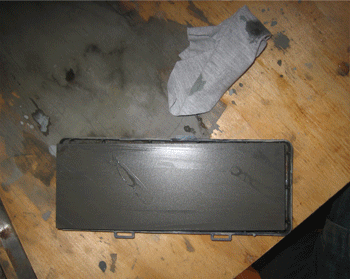  
It's Puerto Rico day here in New York as I write this, and my neighborhood is blowing up. In honor of this celebratory celebration I decided to tune up my brand new (to me) Clifton #4 smooth plane.
A customer returned this particular #4 for reasons unspecified. I haggled with Joel and took it home for a screaming sweet price. (Note to customers: Please return a Clifton #5 1/2 jack plane)
I hollow ground the blade at TFWW then packed the whole thing up and took it home.
The first thing I did was to take everything apart and check it over. One of the pins that hold the frog in place had a slight burr from over-tightening, so I filed it off while my water stones soaked in the bathroom sink.
My 220 grit Norton water stone needed some flattening. I marked the surface of the stone with a pencil and flattened it under running water with a flattening stone.
The Norton 220 grit water stones dish very very easily, so I only use mine when I'm flattening the back of something new or repairing damage.
On the Clifton plane irons when the blade is wet and fresh off the stone you can see a color difference between the hardened steel of the edge and the softer steel that starts a few inches back. It looks a like a mini Rothko.
As I begin using a water stone I apply pressure and add water to work up a fresh slurry of sharp abrasive. I pay attention to any high spots on the stone, and work over them with the iron's back to help keep the stone flat. As I begin to finish up on the stone I use a lighter pressure and stop adding water to allow the abrasive to break down and give an easier transition to the next stone. You can see the texture the stone gets as you let the abrasive break down in the murky-abstract-yellow/grey photo (thats a Norton 8000 grit stone).
I finished the iron on a 10,000 grit Chosera stone. You really do need to use a nagura stone to raise a slurry on the high grit Chosera stones, but once you do it cuts like mad.
Hollow grinding the iron lets the bevel sharpen very quickly, unlike the back which takes forever. I don't bother to get the back of new tools perfect the first time. I would rather spend my time doing other things, and let my tools get progressively sharper as I use them and re-sharpen them. Usually with a plane iron it takes me about 4 or 5 rounds of relaxed-effort sharpening until the back is at maximum polish. Thats totally fine with me because even after the first round of sharpening the iron will shave the hair off my arm.
With the iron sharped I attached the chip breaker, and put the plane together for adjustment. The screws on the frog make it easy to adjust the mouth opening while the blade is in place. This is a real LTS (Luxury-Type-Situation) compared to my #3 "Made in USA" that requires the blade to be removed for frog adjustment. I set the frog so just a sliver of light shows through between the blade and sole.
Throughout the day as I worked on the plane, I could hear air horns, car horns, shouts and screams outside. Our Neighborhood has a large Puerto Rican population, and the streets have been filled all day with cars, motorcycles, wheelchairs, bicycles, strollers and people, decked from head to tail in the Puerto Rican Flag. As I write this I can hear 3 different radios each blasting a different latin tune. The smell of countless sidewalk barbecues is wafting through the window, and there are small explosions outside as folks light off firecrackers.
With the spirit of the day nearly boiling out of street I readied my Clifton. With it dressed for the occasion as an honorary Boricua I set up a board and went to town ....Yeow... ¡Orale mamacita, esta caliente!
What I use to Sharpen:
I use a Norton Combo Stone Kit and a 10,000 grit Chosera Stone (given to me by Joel as a gift, thanks Joel) At first I didn't use my Chosera much because I personally couldn't (still can't) feel a sharpness difference between it and a Norton 8000. However I have found that when I use the Chosera my tools stay sharp longer so now I use it every time. I think the work time I get between sharpness re-ups is worth the extra step.
I try not to use flattening stones (although some times you have to, especially on coarse stones.) They waste the rock you paid good money for. By being mindful of the feel of the blade on the stone it is possible to keep water stones flat longer by using the entire stone, and working the blade over any high spots that develop before they become too large. I seem to remember, although I can't find it now, that Joel wrote a blog entry about this technique as practiced by a visiting customer from Japan.
In general I follow the method of sharpening detailed on the TFWW website here.
|
 Joel's Blog
Joel's Blog Built-It Blog
Built-It Blog Video Roundup
Video Roundup Classes & Events
Classes & Events Work Magazine
Work Magazine

























Schwarz posted a video about keeping (oil)stones flat by wearing the surface evenly while back:
http://www.popularwoodworking.com/woodworking-blogs/chris-schwarz-blog/a-dance-to-keep-your-stones-flat
I flatten my waterstones as I go using a DMT diamond plate (the grit flattening stones are garbage), but distributing the wear certainly let me work longer before it's necessary.